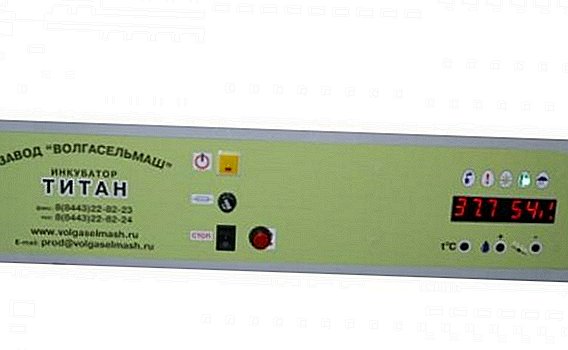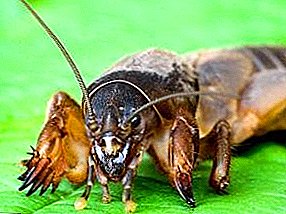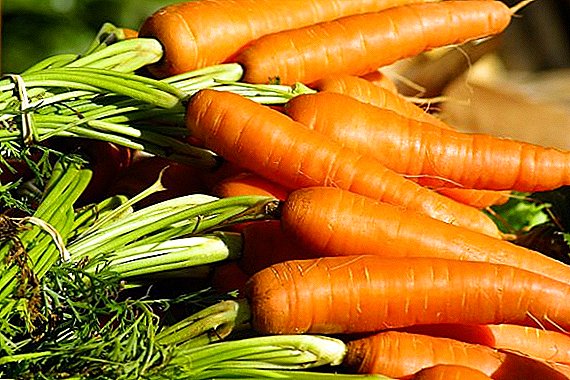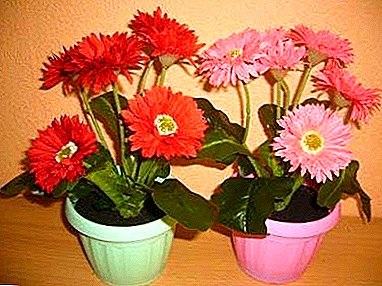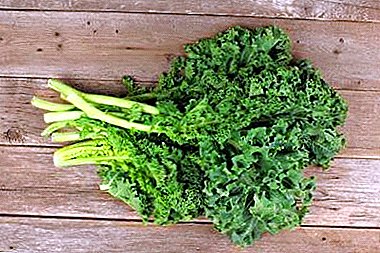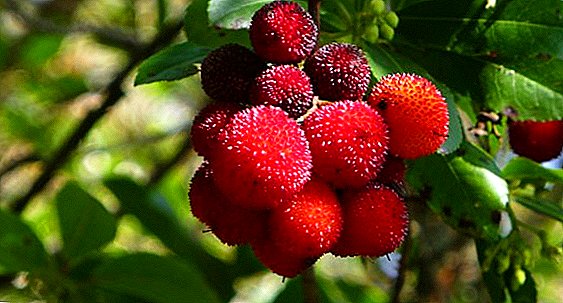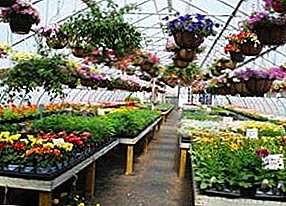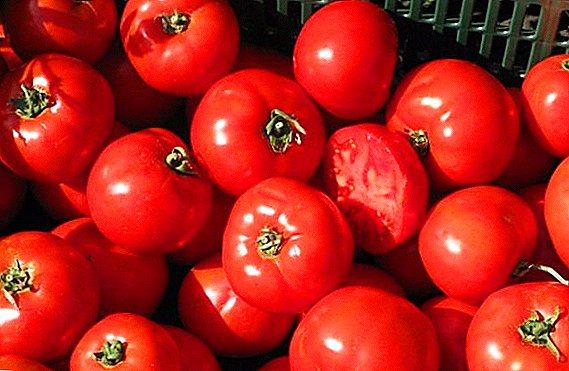 Any gardener would like to have tomatoes on the plot that would delight with taste and yield.
Any gardener would like to have tomatoes on the plot that would delight with taste and yield.
One of these varieties is dedicated to our today's review.
Tomato "Bobcat": description and features
Let's see what this variety is remarkable for and what you should pay attention to when it is grown.
Description of the bush
The plant belongs to the medium-sized varieties. For tomato "Bobcat" the usual name is the height of the bush up to 1.2 meters, since it is up to this size that healthy saplings reach. They look stocky and rather wide, with well developed branches.
Experts know that this species belongs to the so-called determinant. That is, active growth in them occurs only until the appearance of a fruiting ovary at the apex. After that, the bush will no longer "drive" up.  The first brush will appear after 6 - 7 leaves, and between them and the ovary will be a maximum of three leaves. After the appearance of about 6 of these ovaries, growth ends.
The first brush will appear after 6 - 7 leaves, and between them and the ovary will be a maximum of three leaves. After the appearance of about 6 of these ovaries, growth ends.
Fruit Description
These are large tomatoes, weighing 250 - 300 g. Their shape is almost the right circumference, slightly flattened, as befits this culture. To the touch the fruit is smooth, with a glossy surface. The eye is pleased with bright red color, without green specks.
Important! Buy licensed seeds, and in the profile shop you are required to show all the documentation for such material on the first request.Tomatoes do not lose their qualities during the entire period of fruiting.

Yield
Tomato "Bobcat F1", as well as its description, interests us, first of all, because of its yield.
Harvest can be removed after 65 - 70 days after disembarkation. From 1 "square" on a site collect at least 4 kg of tomatoes. The average figure is 6 kg, although some bring it to 8 (but this is in a warm climate and with careful care).
Disease and pest resistance
Such a “Dutchman” is favorably distinguished by good immunity. Common diseases such as Fusarium fungus, tobacco mosaic or verticillus are not terrible for him. If you maintain the desired temperature and irrigation regimes, then powdery mildew will not appear.  The same applies to pests. "Bobkaty" rarely become their place of residence. True, the same aphid can spill over from a diseased plant of another variety growing next door. So regular inspection will only benefit.
The same applies to pests. "Bobkaty" rarely become their place of residence. True, the same aphid can spill over from a diseased plant of another variety growing next door. So regular inspection will only benefit.
Regions for growing
Tomato "Bobcat" was bred for warm areas. In our latitudes, it is best acclimatized in the south, both in greenhouses and in the open field.
Did you know? The first tomatoes brought to Europe struck everyone with their fruits, but for some reason were considered poisonous. Tomatoes were “amnestied” at the end of the 16th century, when the cultivation of crops became widespread.For more northern areas is suitable except the greenhouse method. This is due to the fact that the thermophilic hybrid is picky about temperature and luminous flux. So even a film greenhouse may not be suitable for this variety, especially if the area is characterized by frequent repeated frosts during the spring.
Pros and cons varieties
Many gardeners are engaged in growing vegetables for sale, so their interest in new lines is purely practical. As befits a prudent person, let's count all the advantages and disadvantages that distinguish Bobcat tomatoes when growing this variety. 
First we give the arguments for:
- Spectacular appearance of dense fruit
- Heavy tomatoes
- Good disease and heat resistance
- Do not deteriorate during prolonged storage
- Have a high transportability (even on a long-haul flight, they will not lose their presentation)
- Pronounced thermophilic
Important! It is possible to plant seeds into the ground except in a stable warm climate. It is safer to act "through" seedlings.
- With a large amount of seed labor intensity increases
- Need constant supervision. For country cottage, which is visited once a week and a half, this variety is unlikely to fit. At least on a commercial scale.
Growing tomato seedlings
With the sowing and the seedlings themselves, there will be no particular hassle: these activities are done according to the standard for all tomatoes scheme.
Familiarize yourself with other tomato varieties, such as Mikado Pink, Raspberry Giant, Katya, Maryina Roshcha, Shuttle, Black Prince, Pink Honey.Before starting the landing, the terms are calculated: 65 days are taken from the planned date of disembarkation in the open ground. The time when it is necessary to start seedlings will differ in different regions. If for the southern regions this will be a “window” between February 20 and March 15, then for the middle band the dates are shifted from March 15 to April 1. For the Urals and the northern regions, the time is from 1 to 15 April.
Did you know? A pot with a tomato on the window in the XIX century was a typical picture for our regions.Tomato "Bobcat", as reviews show, does not require additional seed treatment. Warming up, glowing in the oven and the more "chemistry" is inappropriate here.

Let's start sowing:
- Fill the container (pots, tapes or cups) filled with moist clean soil.
- We make grooves with a depth of up to 1 cm and an interval of about 3 to 4 cm between them.
- Between the seeds themselves need to adhere to a distance of 1.5 cm. If there is enough land for seedlings, you can take more. A rarer sifting gives you the opportunity to keep the seedlings in the container longer without resorting to their "resettlement."
- Next you need to fill the holes with primer.
- And in order to keep the desired humidity, we cover the container on top with a film or glass, then placing it close to the battery (so that it is constantly + 25-30 ° C).
Important! Deep drying of the substrate is simply unacceptable.A prerequisite is good lighting. At first, the daylight will be missed, and then a fluorescent lamp comes in handy.
Shoots will break through in 10 - 12 days, or even faster (it depends on temperature).
Fully film is removed after 1.5-2 weeks. Prior to this, give saplings as much attention as possible. Inspect them in the morning, preferably before sunrise, and also during the day: in the warm afternoon, the rays may even harm the seedlings. Any plants have a quenching period, and this quality can (and should) be developed. A container with already appeared shoots can be taken out on the balcony or open a window, if it is outside from + 15 to + 20 ° C.
After two or three weeks, the mature shoots fertilize. For such purposes, recommend organic dressing, but the purchased formulations based on Humin or biohumus will be the way. At this stage, take half indicated on the packaging dose. Further fertilizers are applied at the same interval.
Any seedlings need a swoop. Since "Bobcat" - a tomato and all its characteristics indicate the medium growth of the bush, one such operation will suffice.
Did you know? The first batch of tomato came to Russia in 1780. "Wise Fruit" even allocated a separate crew with protection.They do it when the seedlings are already quite strong (approximately two weeks after their appearance):
- We take a large volume pot with good drainage.
- Carefully undermine the seedling and separate it from the ground mass (try not to hook the greens much, it is better to work with an earthy clod).
- The main root is shortened by about 1/3, by pinching off the unnecessary part.
- In the hole we make phosphate fertilizer.
- Move the seedling to a new place, gently pressing the root.
- Fall asleep rhizome. At the same time, the earth should be heated to at least + 20 ° C.
Learn more about growing other vegetables such as onions, rocambol, cherry tomatoes, gherkin cucumbers, garlic, chili, okra, zucchini.The first time after transplantation growth may stop. Because of this, many refuse to “stop” the spine. Yes, it is traumatic for a plant, but a healthy process will cope with such a shock.
Process and optimal scheme for planting tomato seedlings
One and a half months after sowing, the seedlings will “drive out” the first flower brush. Noticing this, count 2 weeks ahead: it is at this time that the landing on the open area will be made.
Perederzhivat plants in pots is not worth it, because so tomato varieties "Bobkat" partially lose yield.
Important! An undesirable tomato for the "predecessor" in the area is potatoes. These cultures are trying to "breed" that the soil was in the right tone for the bushes.Before planting, make sure the soil is warm. It should be well fertilized with ashes or compost. On the other hand, excessive feeding will make the tomatoes "fattened". Not bad to hold and disinfect the earth with copper sulfate.
The planting scheme is simple: 4 - 5 plants are added dropwise on a 1 m² plot, adhering to the “chess” order. That is, the distance between the bushes should not be less than 0.5 m. The 40 cm spacing customary for other varieties will not work (Bobcats have a ramified rhizome). The process of planting itself is simple:
- Digging holes that immediately pour.
- While moisture is being absorbed, seedlings with an earthy clod are carefully removed from the pots.
- Holding the lump, the sapling is moved to its permanent place. In the course of this work, the central stem is slightly deepened into a wet hole (a couple of centimeters will be enough) to allow additional roots along it.
- The wells are gently covered with earth.
Features of care and cultivation agrotechnics
For good yields need care. Our hybrids are quite unpretentious, but require constant attention from the owners.
Did you know? The composition of the fruit is lycopene. It prevents the appearance of cancer cells and smoothes chronic inflammatory processes.
Watering and mulching
Plants of this variety tolerate hot days well. True, it is better to maintain high soil moisture. Look at the weather - in the summer of two irrigations a week will be enough. With high clouds, one abundant irrigation during the same period is enough.  Everyone knows about the benefits of mulching. A lot of materials are used for this, so we will tell about them in more detail. The beds are covered:
Everyone knows about the benefits of mulching. A lot of materials are used for this, so we will tell about them in more detail. The beds are covered:
- Mowed grass (the easiest way, which is suitable for both greenhouses and open land). The grass lies down after a couple of days of drying (do not rush to lay immediately after mowing).
- Compost
- Universal straw (a layer of 10 cm eventually settles to 5, so you can put all 15 cm).
- Previously popular burlap will also retain moisture;
- Tightly fitting film will be a barrier from pests (it is interesting that for tomatoes it is better to take a red material).
Top dressing bushes
It is better to do it regularly, every 2 weeks. If for some reason this schedule is not maintained, then the bushes are fed at least three times a season.  The fertilizers themselves also have their own requirements: for example, there must be more phosphorus with potassium in solution than nitrogen. The presence of individual components is also important: boron is needed by plants when they have already begun to bloom, whereas magnesium-based preparations will be appropriate at any time.
The fertilizers themselves also have their own requirements: for example, there must be more phosphorus with potassium in solution than nitrogen. The presence of individual components is also important: boron is needed by plants when they have already begun to bloom, whereas magnesium-based preparations will be appropriate at any time.
Important! 50 g of superphosphate, 35 g of potassium chloride and 15 g of ammonium nitrate can be added to a 10-liter bucket of water. Mixing them, get a good fertilizer.The same boron in the form of acid is interfered with in the proportion of 1 g / 1 l of water, after which the green mass is sprayed.
Top dressing is best done in the afternoon.
Masking
This manipulation can be carried out regularly, without letting the stepchildren grow up to 3-4 cm.
The first cleaned shoots that appear under the brushes. If you tighten the plant can easily reset the flower with the ovary.
There is no special trick here: clasping the stepson with two fingers, gently break them out, moving them to the side. Cut off sharply not worth it. If they are already large, you can use a knife.
To form a bush in three stalks, you have to leave the strongest escape, which appeared above the second. For the two stems, we act in the same way, only we leave the process already above the first brush.  These procedures should not be dealt with in the heat, so as not to injure the bush once again. In rainy weather, on the contrary, it will be necessary to clean not only the stepsons, but also the lower leaves.
These procedures should not be dealt with in the heat, so as not to injure the bush once again. In rainy weather, on the contrary, it will be necessary to clean not only the stepsons, but also the lower leaves.
Garter to the support
Seedlings rooted and went to growth - it's time to tie. A meter peg is enough, it is driven to a sufficient depth of ten centimeters from the stem.
Did you know? The largest tomato is considered a 2.9-pound fruit grown by a farmer from Wisconsin.The bush can be “grabbed” to the horizontal trellis, it is even better in terms of yield. Yes, and more convenient for processing and cleaning.
As for the other "agrotechnics", such measures are reduced to hilling (3 times per season) and cleaning the weed when it appears.  Now you know what Bobcat is good at and how to get tasty, weighty tomatoes. Record harvests!
Now you know what Bobcat is good at and how to get tasty, weighty tomatoes. Record harvests!


